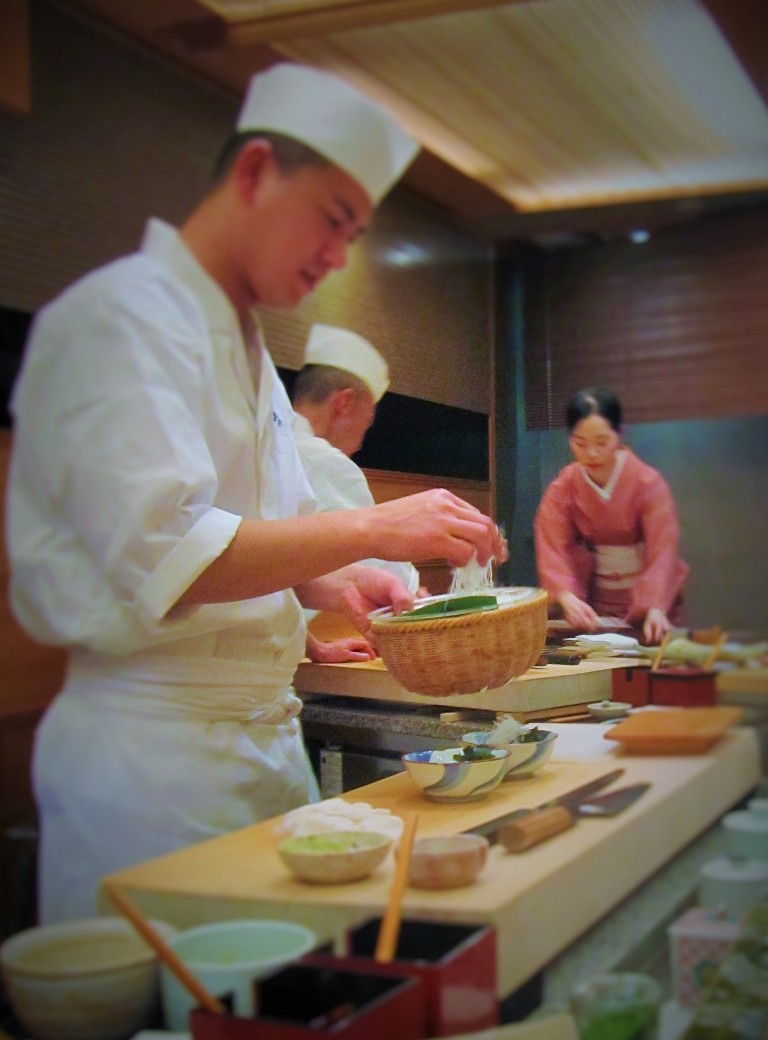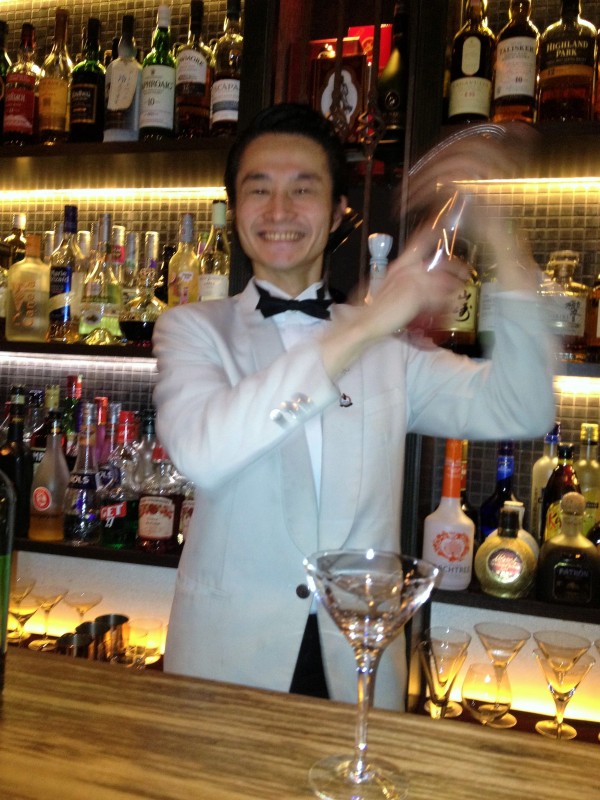There are a million and one reasons to go to Tokyo. There are also a million and one blogs and articles about what to see and do once you’re there. Because of this, I’ll aim to take another direction with this post and focus on my two favorite subjects: food and drink.
After living in Asia, one of the common cultural descriptions that you hear about the Japanese is that they are extremely meticulous. A prior client of mine would always reiterate that working with her Japan team took three times as long as the other regional teams, and that before a project could begin, she’d sit in week long meetings going over every little detail. However, once the project was complete, it was perfect. The other regions were quicker, but it was never done to the perfection of the Japanese.
This generalization holds true when it comes to both food and drink. Watching the chefs or bartenders prepare your order is like watching a surgeon perform surgery (or at least I can imagine), with every single step taken with the most precise and careful detail, knowing that one bad move can result in failure. Many traditional Japanese restaurants have intimate layouts where you can watch or even interact with the chef throughout the course of the meal.
However, it isn’t all show and no substance. Whether it was ramen, kaiseki, sushi or yakatori, Tokyo served the best food I’ve had in Asia without question, though others will contest me and say South Korea. The Japan vs. South Korea food debate is a big one here. That said, if you’re a sushi addict, I would encourage you to put Tokyo at the top of your destination list.
If I could, I’d write ten pages on the food and drinks of Tokyo. However, knowing that no one wants to read that, I’ll stick with my favorite restaurant and bars.
Kyubei: If I could only chose one meal to have again for the rest of my life, Kyubei would be at the top of the list. The personalized dining experience combined with the theatrical performance of the sushi chefs paired with the freshest fish that one can find truly makes eating at Kyubei a one of a kind experience.
If you’ve seen the hit documentary Jiro Dreams of Sushi, Kyubei is a direct competitor to Sukiyabashi Jiro, but more affordable. It’s run by Yosuke Imada, the 62-year-old owner, whose father started the restaurant in the 1930s. Today, it’s one of the most renowned sushi establishments in the world, known for its quality and service. With one step into the restaurant, it’s easy to see why.
The experience starts the moment you walk into Kyubei, a relatively informal restaurant despite its prestige. The hostess greets you at the door and immediately whisks you to your seats at the sushi bar. The sushi chefs at Kyubei only serve up to six people each, making the experience both special and personal.
For dinner, the most common selection is the Omakase, meaning chef’s choice. It allows the chef to choose and serve the freshest fish of the day while also keeping diners on their toes, not knowing what dish is coming next. Other options are the set meals which come with the addition of grilled fish, but come at a much steeper price.
As the documentary Jiro exposed, it takes decades of training to become a reputable sushi chef, a job of status and prestige in Japan. A sushi chef at a restaurant like Kyubei is similar to celebrity status in the States. And, it’s not hard to see why. The ability to craft and present a perfect bite of sushi is an art, taking not only technical skill and precision but also the ability to do it in a playful and engaging manner, capturing the audience’s attention.
I watched in awe as our chef prepared the sushi for us, making each piece one by one and step by step. First, the chef will take his 11-inch bladed sushi knife, which looks more like a samurai sword, and slice the raw fish in one swift diagonal motion to ensure the cut is clean and smooth. Then, with the palm of his hand, scoop up a small spoon-sized pile of rice from the rice basket next to him, molding it in his palm to make it a bite-sized oval shape. With his forefinger, he takes a dollop of fresh wasabi and spreads it on the rice. He does all of this in quick, distinct pulses, wasting no time on each step.
There’s four different methods to making nigiri sushi (traditional Japanese sushi with fresh fish on top of rice) with each method defined by the movement of the palm, hand and fingers to ensure the fish is perfectly pressed on top of the rice. The ability to do the ‘hand flip’, squeezing, pressing, rotating and flipping the sushi to ensure its final press of fish-to-rice is flawless, is what makes a sushi chef a sushi chef. With each piece of sushi made, I tried harder and harder to memorize the twists and turns of the hand press, but a true sushi chef does this so quickly that an amateur like me couldn’t keep up.
Before serving, the chef spreads a light layer of soy sauce on the top of the fish, if it calls for it, and places it on your plate. All you have to do is eat it in one big bite; two bites makes you stand out like a sore thumb. The chef continues the same song and dance throughout the meal, making the sushi in individual pieces and serving it one by one.

But, the presentation is only half of the reason you come to Kyubei. The fish itself is truly remarkable. When I had my first piece of toro sushi, I didn’t know what I was tasting, despite that I’ve eaten sushi weekly for the past few years.
The sushi is like no other. The freshness and clean taste of the fish paired with the airy, light rice melts in your mouth, a description I cannot imagine giving to sushi. The time spent sourcing and preparing the fish and rice ahead of service shows, to say the least.
Our meal started with chu-toro (medium fatty tuna), followed by (in no particular order) snapper, salmon, yellowtail, uni, eel, shrimp, multiple types of tuna, tamago and ended with maki and soup. One of the most memorable dishes was the shrimp sushi, as the chef began this course by showing us our serving of two enormous live shrimp, asking if we wanted them cooked or fresh (ie. raw). Choosing fresh, he ripped off their heads, cleaned them and then pressed them on top of the rice. The chilled, raw taste and smooth texture of the shrimp was one of the best dishes of the night, next to the tuna which had a perfect balanced flavor compared to many tunas which can be too fishy or no flavor at all.
Overall, this experience made my Japan trip, and provided a true glimpse into Japanese sushi culture. Learning and seeing how traditional sushi should be prepared and how it should taste was one of the most unique experiences I have had. Whether you’re a sushi addict or not, I would encourage you to make a trip to Kyubei.
Bar Dolphy: If you’re lucky enough to stumble upon this hidden bar on the streets of Ginza, you’ll know it by the troves of cigar smoke that immediately hit you when you walk in. It’s old fashioned, dark and musky, made up of deep shades of mahogany and seats only eight people. Fitting with the theme, the only other person in the bar was an older man dressed in a trench coat and detective’s hat, smoking a cigar and drinking whiskey with the bartender. He played well into my imagination of spies and detectives coming here in the 1970s for a drink after a long day’s work.
The bartender, dressed in a perfectly pressed white coat and black bowtie, immediately came up to us, making as much small talk as we could given the language barrier. We ordered a Manhattan and Old Fashioned and watched in awe of the precision and attention to detail of which he made each of our drinks. Tongs were used to place the ice, the vermouth and bitters were poured into glass with swift yet careful precision and the garnish was perfectly sculpted and slowly put into the delicate glass to ensure its specific place. You could feel the pride the bartender had in his profession and his enjoyment in pouring, stirring and placing the drinks in front of us.
After a few sips of our Old Fashioned and Manhattan, our bartender laid out two white napkins, putting a fig tart next to the old fashioned and small pastry next to mine. We learned that not only do you get perfectly balanced and crafted drinks at Tokyo’s cocktail bars, but each drink also comes with an amuse-bouche, paired with your drink order.
Bar Dolphy was the first cocktail bar we stumbled into in Tokyo, thinking that we had found a hidden gem. However, after a few more cocktail bars, we learned that this attention to detail, focus on presentation and custom amuse-bouches was part of the cocktail bar experience. Compared to our overly-sweet, candy-coated Old Fashioneds in Hong Kong that are made and served in 60 seconds, we couldn’t get enough of Tokyo’s cocktail culture.
Our next bar, on the same street in Ginza, provided an equally special and intimate experience. Similarly to Bar Dolphy, the bartender played a large role in shaping the experience for the guests. While our bartender at Bar Dolphy was somber and serious, creating a demure yet mysterious atmosphere, our second stop was the exact opposite.
Dressed in a gray sports coat and black bowtie, our second bartender was playful and affable, smiling and laughing the entire time. While just as meticulous as bartender #1, he put on a mini show for us each time he made a drink, shaking the cocktail shaker a little too hard or above his head, successfully trying to elicit a response from us.
Next to us at the bar, which also only sat about eight people, were two local women out on the town for a girls’ night. Their husbands were watching the kids and they were taking full advantage. I immediately loved them because one of the women hit Matt on the side, telling him he is lucky to be dating ‘Julia Roberts’, which clearly is the only western celebrity that they knew, but I’m still holding onto it!
We ended up chatting with the two women for some time, but when I say ‘chatting’, I really mean using our hands to explain things, showing each other photos and speaking in tones about three times louder than usual, thinking that we could understand each other if we just spoke a little louder. Neither of us could speak each others’ languages, if you didn’t guess, but I did manage to understand that they had bought new purses that day, which they pridefully showed me over and over. They were brown leather with multicolored puff balls on them. The ones you glued to paper during arts and crafts at day camp.
Thirty minutes later, one of the women ended up passing out at the bar table, but not before they gave Matt and I a few glasses of champagne.
While these women were hilarious, and I can only hope that I too will have those girls’ nights with kids, what was most striking was how kind and welcoming everyone we met in Tokyo was. Compared to many places we’ve traveled in Asia, the friendliness of the Japanese was a well-needed breath of fresh air.
















Nice pics.
LikeLike